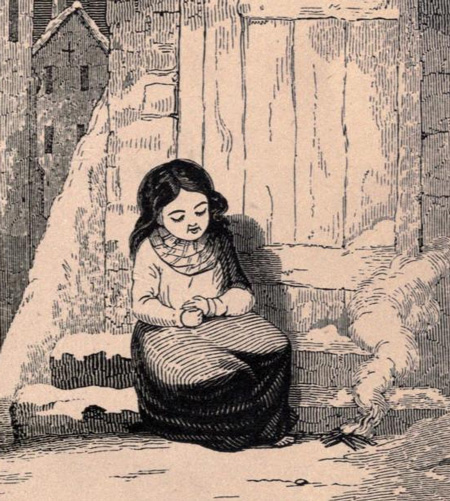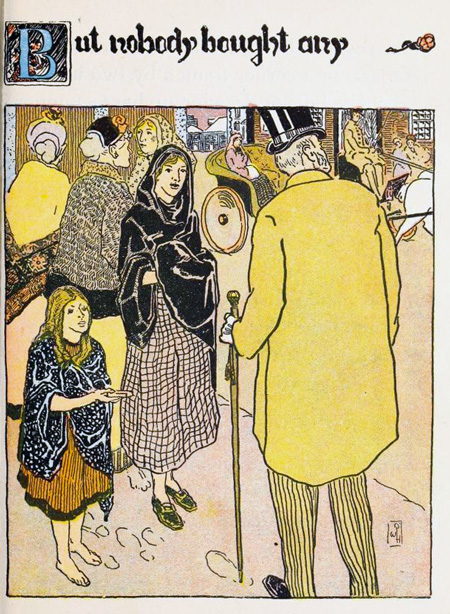James Williamson, a Scottish chemist turned motion picture pioneer, adapts Hans Christian Andersen’s tragic fable for the screen and showcases some impressive special effects in the process.
The Spark
The early days of motion pictures featured such a variety of films that it’s almost a crime that the conversation is hogged by angry moon faces, workers leaving factories and train robberies, charming though they are. It didn’t take the early cinema pioneers long to realize that audiences were eager to see popular stories from other forms of entertainment adapted to the screen.

Hans Christian Andersen’s 1845 story The Little Match Girl (Den Lille Pige med Svovlstikkerne) should be pretty familiar. A small child tries to sell her wares on the freezing street. Nobody buys them and she doesn’t dare return home without a single sale. As she slowly dies, she ignites the matches and is delighted by the visions of warmth, food and family that she sees. The next day, her frozen body is discovered by people who cannot know what she saw before her death. Curtain.

I prefer my fairytales with more of a German accent, to be honest, but Andersen’s story was made to be filmed and to be filmed at the dawn of the movies. Nowadays, short live-action dramatic films are pretty much limited to film festivals where they are used to show that the director is worthy of making the jump to features. However, there is something so clean and elegant about the dramatic short that I wish the art would be resurrected in a more universally accessible format.

In 1902, there was really no question of “opening up” the story or incorporating it into the Hans Christian Andersen Cinematic Universe. The story is adapted for the screen as-is and the little protagonist’s dying visions are used as a vehicle for the new field of cinematic special effects. Further, its sensitive portrayal of an impoverished child was very much in line with Williamson’s desire to use movies to draw attention to social issues. (Anybody who longs for the “good old days” when movies were not political, avoided current events and were “just entertainment” is probably going to be disappointed.)
The special effects have historically been the main draw for the film with Williamson’s superimpositions being particularly praised. Indeed, they are smoothly and cleverly incorporated and the young actress who plays the doomed match seller interacts well with the imaginary images before her. Her attempts to eat a holiday turkey dinner are particularly successful. And we think modern green screen action is challenging; imagine the challenges on the set of this pioneering work!

Some historians have remarked on Andersen’s remarkable prescience in incorporating the idea of images being projected onto a wall a half-century before the first film was shown on the big screen. While I certainly do not wish to diminish Andersen’s talent, I should point out that magic lantern (early image projectors) shows were documented in Copenhagen as far back as the seventeenth century. While Andersen’s imagery is undeniably powerful, it is likely that he was inspired by one of these shows. It’s important to realize that movies did not spring out of the Black Maria full formed; they built on older technology to create something new.

While The Little Match Seller makes excellent use of special effects it keeps its feet firmly planted on the ground, an element that was common in early British film. For comparison, R.W. Paul’s zany trick film The ‘?’ Motorist revolves around a couple attempting to avoid a traffic citation. The fact that they drive into outer space and zip around the rings of Saturn is neither here nor there. Cecil Hepworth’s Rescued by Rover involves a genius dog saving the say but maintains its cozy, homey feel thanks to the fact that the cast is made up of the Hepworth family and Rover is played by the family dog.

It would be easy to frame this discussion as a rivalry between the whimsical fantasies of Georges Méliès and the more grounded British producers but doing so would ignore the fact that Méliès was quite capable of popping his head out of the studio and incorporating the real world into his reel world. For example, his 1899 series on the infamous Dreyfus court-martial was both torn from the headlines and deadly serious. Even in his more whimsical work, Méliès could take a more serious approach and touch on topics like suicide and colonialism. (Cough, cough, good old days when movies were not political… Oh, you poor bunnies.)

That being said, Williamson’s silent films have a definite and immediately recognizable darkness. With titles like Fire! and Attack on a China Mission, there was no doubt that he was attracted to bombastic, tragic content. With The Big Swallow, one of my very favorite early films, Williamson pokes fun at the irritations of a persistent cameraman and uses an extreme closeup to illustrate his solution to the problem: cannibalism. Obviously.
While the visions that the little match seller experiences are brought to the screen with confidence and flair, we don’t lose sight of the fact that it is cold and dark and a child is dying before our eyes. Dying children were common plot devices in this era but to Williamson’s credit, he does not overplay his hand. The tragedy is all the more heartbreaking for the matter of fact way it is presented.

Williamson’s version of The Little Match Seller stays close to the source material—he would have been a fool not to make use of a movie-ready story like that—but still incorporates the director’s unique imagination. British film pioneers are often overlooked in favor of their flashy French and American rivals but Williamson deserves an honored spot next to Méliès, Porter and Guy. The Little Match Seller is a great introduction to his talents, especially as a double feature with The Big Swallow. That’s a lot of movie history to enjoy in less than ten minutes.
Where can I see it?
The Little Match Seller is available for streaming on the official YouTube channel of the BFI.
***
Like what you’re reading? Please consider sponsoring me on Patreon. All patrons will get early previews of upcoming features, exclusive polls and other goodies.
